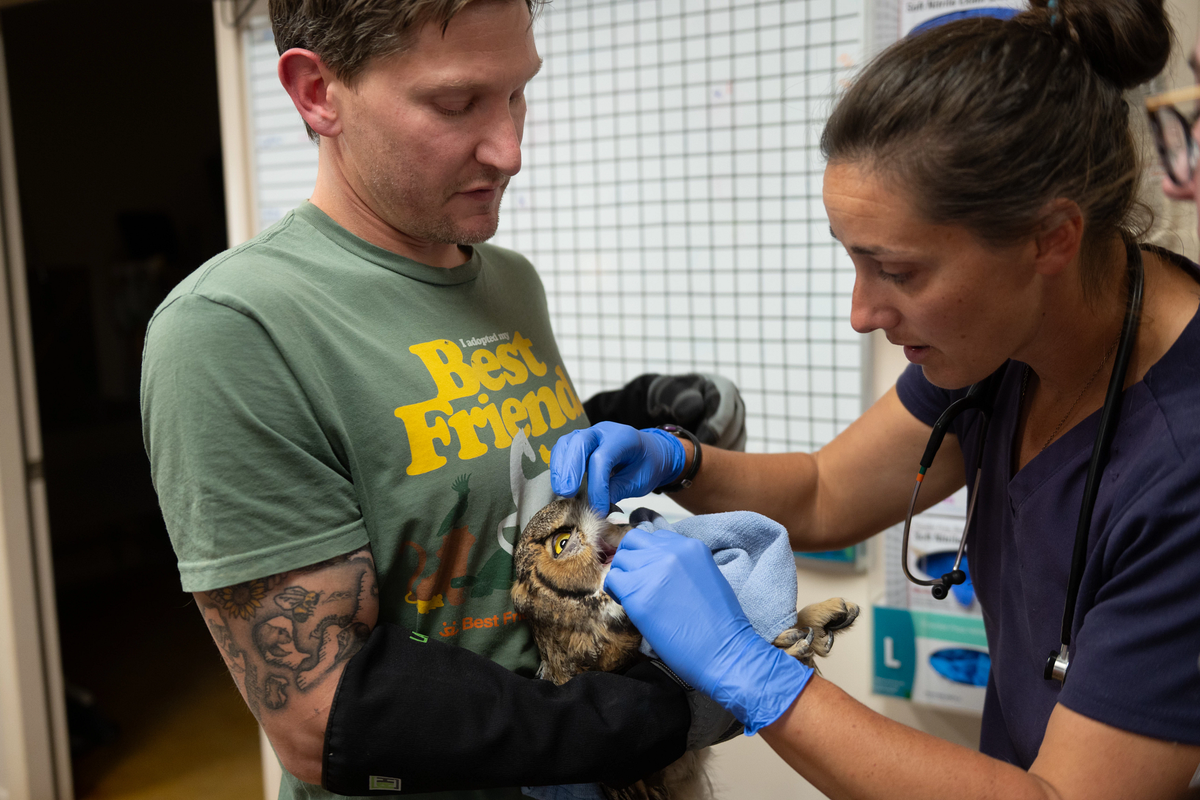A young owl fell into a concrete mixer. Wildlife rehabilitators had to improvise to save him.
No one they called had any experience helping an owl that had fallen into concrete.

A juvenile owl gets help after falling into a concrete mixer.
Humans and wildlife coexisting together sometimes leads to unexpected encounters, as well as unfortunate mishaps. Wild animals generally have strong survival instincts, but sometimes they're just not enough.
Such was the case of a juvenile great horned owl who somehow fell into a concrete mixer on a construction site in Utah. Someone found the bird and reported it to the Department of Wildlife Resources, who then called Best Friends Animal Sanctuary in Kanab, Utah. When the sanctuary workers procured the owl, about 25% of its body was covered in dried concrete.
“We reached out to other wildlife rehabilitators and they had never heard of an owl falling into concrete before, either,” said Best Friends Animal Society’s Wild Friends supervisor Bart Richwalski.
That meant the team would have to figure out on their own how to remove the concrete without causing damage or harm.
“After doing some research, our team quickly came up with a plan to help the owl in the least invasive way possible," he said.

Richwalski and the team believe the owl was likely born this past spring. "He's a youngster. That's probably how he ended up in a concrete mixer," he said. They also believe he's a male based on size.
When they got the owl to the facility, they found that most of the concrete was on the right side, though most of his body had some amount of dried concrete within it.
"An owl needs silent flight, and the wings were damaged to the point where that wouldn't have been possible," Richwalski said. "But his feathers were also sticking together because of the clumps of concrete."
They started treating him by very gently crushing the bigger pieces of concrete with hemostats and forceps, then using their fingertips to crumble the smaller pieces. Then, in 20-minute sessions while the owl was under anesthesia, they'd bathe him with Dawn dish soap and water, gently cleaning him with a toothbrush and then drying him thoroughly. He also got an x-ray to check for skeletal damage.

"Surprisingly, the owl was very accepting of his treatment here and his care," Richwalski said. "He did start getting feisty by the third day, but that's typical of an owl in distress."
The plan was that once all of the concrete was removed, the owl would be moved to a series of enclosures, each one larger than the last, so they could test his flight abilities in a safe environment.

The owl's long-term prognosis looks good, according to Richwalski. "We expect that he will molt next spring, which will hopefully bring in some fresh, non-damaged feathers," he said. New feathers should allow him to fly silently, which is what allows owls to be effective hunters. Hopefully, that will happen in late spring or early summer.
"Once our owl friend recovers, we anticipate taking him back to near where he was found—not on the construction site, but somewhere that is a natural habitat for him, and release him and let him be," Richwalski said.
Since being thoroughly cleaned, the owl has been moved to his first enclosure, where he was able to get himself up onto a 6-foot perch. Richwalski said that's a promising sign that nothing but his feathers were damaged. We hope to see the little fellow find his way home next summer!
You can learn more about Best Friends Animal Sanctuary here and the Wild Friends certified wildlife rehabilitation center here.

